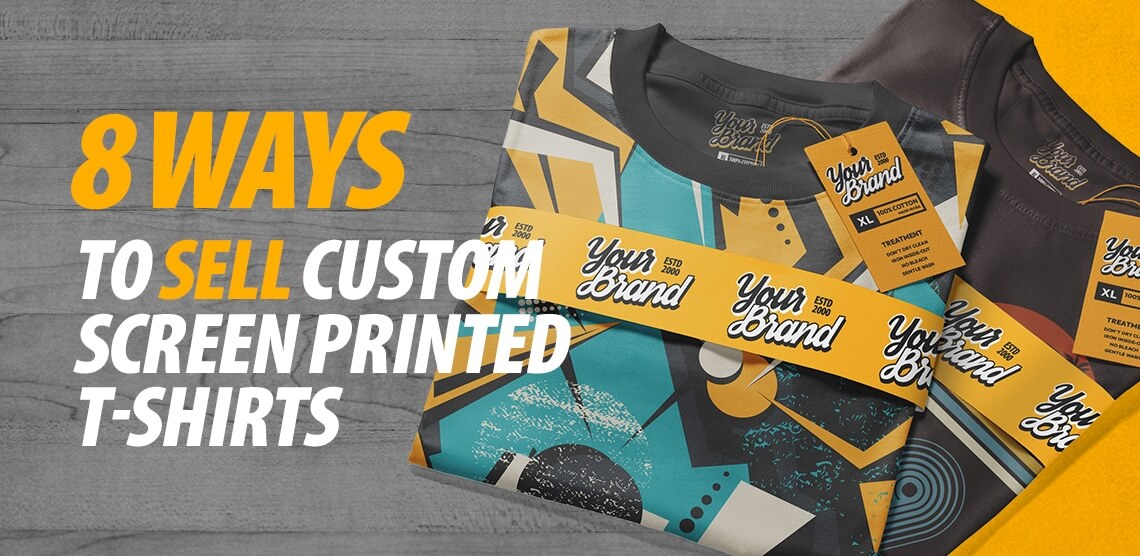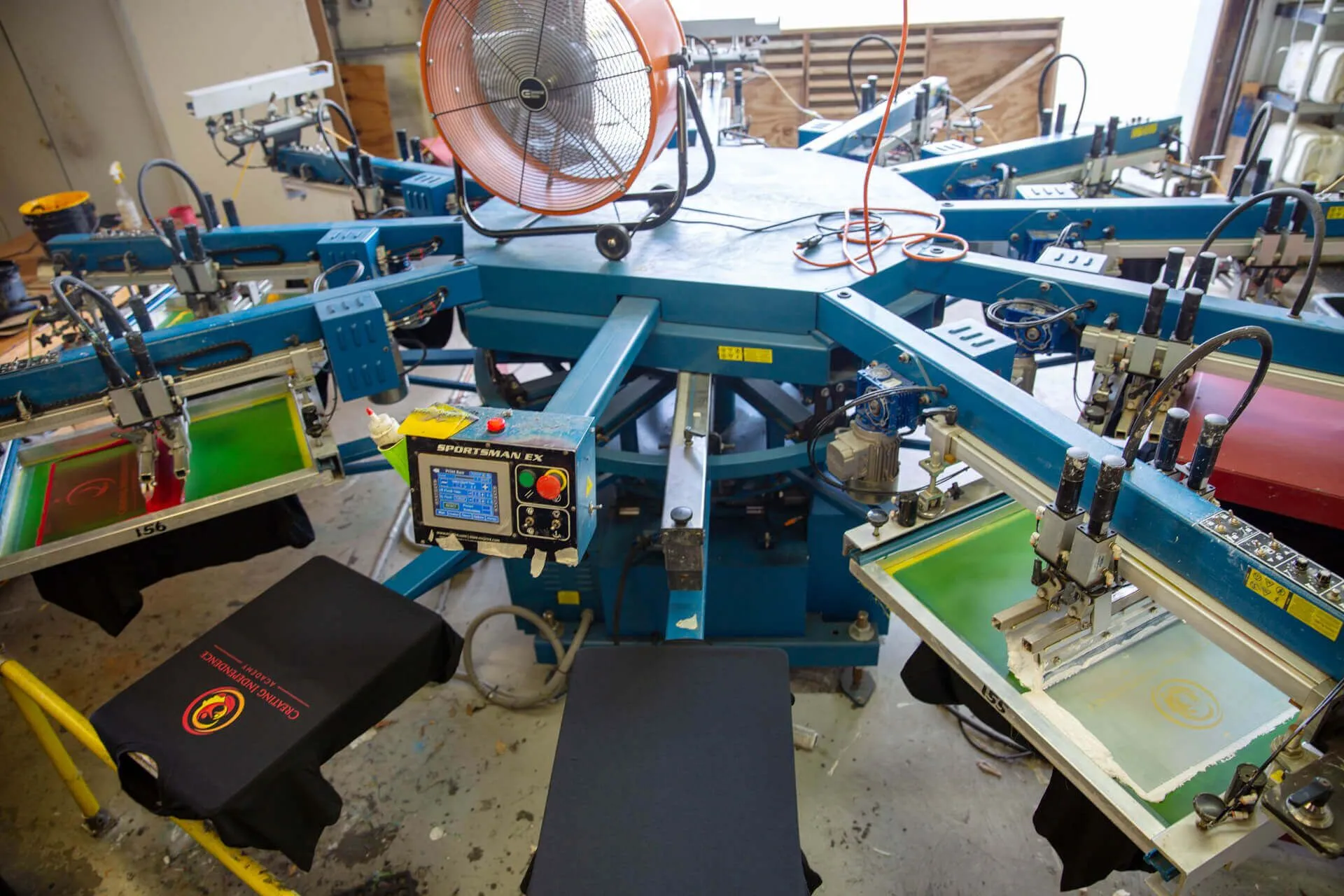Display Printing Uncovered: Every Little Thing You Need to Learn About T-Shirt and Garment Printing Techniques
If you have actually ever asked yourself how those dynamic designs wind up on your favorite t-shirts, you're in the ideal area. Screen printing is a fascinating method that integrates art with method, providing limitless opportunities for creative thinking. Recognizing the fundamentals, from tools to ink selections, can considerably influence your outcomes. All set to explore the important components that make display printing an art type? Let's reveal the details that can elevate your jobs.
The Fundamentals of Display Printing: Just How It Functions
When you dive into screen printing, you'll uncover it's both a scientific research and an art. At its core, screen printing entails producing a stencil, or display, that permits ink to travel through just in certain locations (screen printing kit). You begin by picking your style and preparing your screen with a light-sensitive solution. Once you subject this solution to light, it solidifies, leaving your design as an unfavorable space.
Setting the display over the fabric, then utilize a squeegee to press ink through the screen onto the garment. Each step is crucial, and mastering them will certainly boost your screen printing skills, changing straightforward garments into special, meaningful items.
Types of Screen Printing Methods
Once you comprehend the essentials of display printing, it's time to check out the numerous techniques that can raise your layouts. One preferred approach is conventional display printing, where ink is pressed through a stenciled screen. This strategy is fantastic for strong, vibrant colors. After that there's water-based ink printing, which offers a softer feel and is environment-friendly, but it requires a various approach to treating.
If you're intending for fine details, consider discharge printing. This strategy eliminates dye from the fabric, leaving a soft, classic appearance. One more option is plastisol printing, recognized for its durability and vivid shades, making it a preferred for numerous brand names. Experiment with halftone printing to produce gradient results and complex designs. Each strategy has its one-of-a-kind appeal, so don't hesitate to attempt them bent on discover what suits your design best!
Necessary Equipment for Display Printing
To achieve magnificent results in display printing, having the right devices is fundamental. You'll need a tough screen printing structure, which holds the mesh that moves your style onto the garment. Next off, purchase high-grade squeegees; these are essential for using ink uniformly across the display. You'll also call for a great exposure device to produce your displays, along with a washout cubicle for cleaning them after usage. A reputable heat resource, like a conveyor clothes dryer or heat press, is important for curing your prints to ensure long life. Don't fail to remember a correct workspace, furnished with tables and storage space for your supplies. Lastly, safety equipment, such as masks and gloves, will keep you risk-free from chemicals and inks. With the right tools, you'll be well on your method to creating professional-quality prints.
Selecting the Right Inks and Materials
When choosing inks and materials for screen printing, you require to consider the kind of ink that functions finest for your job. Believe about fabric compatibility to guarantee your layouts look last and great lengthy. Explore eco-friendly ink alternatives to make your printing procedure a lot more sustainable.
Sorts Of Display Inks
Selecting the best screen ink is important for achieving vibrant, durable prints that meet your task's demands. There are a number of types of screen inks to check out. Plastisol ink is preferred for its adaptability and simplicity of use, providing superb shade opacity on dark textiles. Water-based ink, on the various other hand, supplies a softer feel and is environment-friendly, making it excellent for those aiming to lessen their ecological effect. Release inks eliminate dye from the material, resulting in a soft, classic appearance however require certain handling. Specialized inks, such as glow-in-the-dark or metallic, can include unique impacts to your layouts. Assess your task demands and pick the ink that lines up ideal with your preferred end result.

Textile Compatibility Factors To Consider
Understanding fabric compatibility is essential for achieving high-grade display prints, specifically given that different materials react uniquely to various inks. Always examine your inks on sample fabric to guarantee they stick properly and maintain color stability. Furthermore, maintain in mind that textile weight and appearance can impact the final result, so choosing the right ink and material combo is essential for your project's success.
Eco-Friendly Ink Options
Eco-friendly inks are becoming a popular option for screen printers who desire to lessen their environmental impact while preserving top quality. When picking inks, take into consideration water-based inks, which are less harmful and less complicated to tidy up compared to traditional solvents. These inks bond well with fabrics, supplying lively results without hazardous chemicals. You may additionally discover eco-solvent inks that utilize less volatile natural compounds (VOCs), making them a safer option over here for both your health and wellness and the planet.
Additionally, try to find inks made from eco-friendly resources, such as soy or vegetable-based alternatives. By selecting the ideal inks and materials, you'll not just produce sensational designs however additionally add to an extra sustainable printing procedure. Make the button, and your prints will certainly show your dedication to the environment!
Preparing Your Layout for Screen Printing

Submit Format Needs
To ensure your design looks sharp and vibrant on material, you'll need to pay close attention to submit layout requirements for screen printing. Make sure your design has a clear history to avoid undesirable white edges on your prints. Keep shade modes in read review mind; CMYK is typical for display printing, so transform your RGB develops appropriately.
Color Splitting Up Techniques
Shade splitting up is an essential action in preparing your layout for screen printing, and grasping it can greatly enhance your print quality. You'll need to damage your layout into private shades, as each color requires a different screen during printing. Start by recognizing all the shades in your design and produce layers each. You can use software application like Adobe Photoshop or Illustrator to isolate and different shades successfully. Be certain to conserve each layer as a different file, generally in a style like TIFF or PSD. This precision not only ensures exact shade depiction but additionally streamlines the printing process. By taking note of color separation, you'll achieve dynamic and specialist lead to your screen-printed garments.
Resolution and Size
Achieving the most effective cause screen printing starts with guaranteeing your layout has the appropriate resolution and dimension. Preferably, your art work must be at least 300 DPI (dots per inch) for sharp, clear prints. If you utilize lower resolution, your final product may look pixelated and unprofessional.
When it pertains to size, consider the measurements of your print area. Style your artwork to match the final print dimension, preferably developing it in the actual dimensions you'll be publishing. In this manner, you'll stay clear of any unanticipated scaling problems.
Always inspect your style in both vector and raster styles. Vector graphics can be scaled without losing top quality, making them suitable for screen printing. Preparing appropriately will guarantee your design looks outstanding on every garment!
Step-by-Step Display Printing Process
Display printing is a dynamic process that allows you to create lively styles on various surfaces. To begin, you'll require a screen, emulsion, and your chosen ink. Prepare your screen by cleansing it thoroughly. Next off, apply the solution uniformly and let it dry look at more info in a dark area. As soon as completely dry, subject your display to light with your style put on it, which will certainly set the solution where the light hits, creating a stencil - screen printing kit.
After rinsing the unexposed solution, your screen prepares. Establish it up on your printing surface area and straighten your garment under it. Pour ink onto the screen and make use of a squeegee to push the ink with the pattern onto the material. Lift the display thoroughly and let the print completely dry. Ultimately, cure the ink making use of warmth to ensure longevity. That's it! You've successfully screen printed your design.
Tips for Successful Display Printing Projects
While you're diving right into your display printing jobs, bear in mind that preparation is key to success. Start by gathering all your materials-- inks, garments, screens, and mops. A tidy work area aids protect against undesirable errors, so clean up prior to you start.
Next, verify your art work is high-resolution and effectively sized for your garment. Test your display for correct exposure and tidy it completely to avoid smudges. When mixing your inks, follow the supplier's guidelines to accomplish the best uniformity.
Throughout printing, apply even stress with your squeegee for constant outcomes. Do not hurry; take your time to confirm each print fulfills your requirements. After printing, allow your garments completely dry completely prior to handling or packaging them.
Lastly, always maintain an example of your benefit future reference. In this manner, you can analyze your development and boost your methods with time. Satisfied printing!

Frequently Asked Inquiries
How Lengthy Does It Take to Establish a Screen Printing Job?
Establishing up a screen printing job typically takes about 30 mins to an hour. You'll prepare the displays, mix inks, and change the press. The time differs based on complexity and experience, so remain arranged!
Can I Publish on Different Fabric Enters Using the Exact Same Method?
Yes, you can publish on various textile kinds making use of the same strategy, however you'll require to adjust your settings and inks. Some materials take in ink differently, so exploring guarantees the very best outcomes for each and every material.
What Are Usual Errors to Prevent in Screen Printing?
When screen printing, avoid usual mistakes like utilizing the incorrect ink, ignoring appropriate exposure times, or skipping pre-press checks. Constantly check your setup and maintain tidy screens to ensure high quality results each time.
Just How Can I Appropriately Tidy and Preserve My Display Printing Equipment?
To appropriately clean and keep your display printing tools, you need to frequently clean displays with proper solvents, examine mops for wear, and guarantee all tools are stored dust-free and completely dry. Consistency enhances and protects against expensive repair work efficiency.
Is Screen Printing Environmentally Pleasant Contrasted to Various Other Techniques?
Screen printing can be a lot more ecologically friendly than various other approaches, specifically if you utilize eco-conscious materials and water-based inks. By selecting lasting products and techniques, you reduce waste and minimize your influence on the earth.
Display Printing Uncovered: Whatever You Required to Know Regarding T-Shirt and Garment Printing Strategies
At its core, display printing entails developing a pattern, or display, that permits ink to pass via just in particular locations. Placement the display over the fabric, then utilize a squeegee to press ink with the display onto the garment. One preferred method is conventional screen printing, where ink is pressed via a stenciled display.When picking inks and materials for screen printing, you require to take into account the type of ink that works ideal for your project.